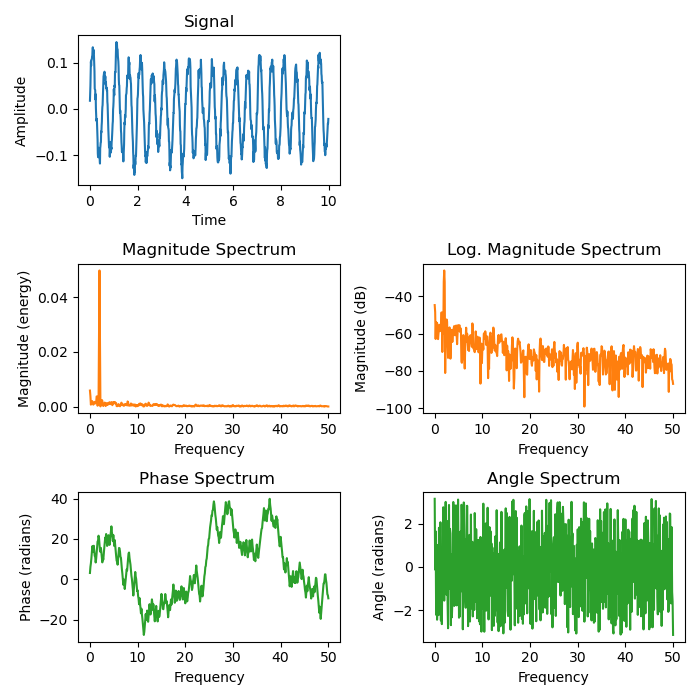Note
Click here to download the full example code
Spectrum Representations¶
The plots show different spectrum representations of a sine signal with additive noise. A (frequency) spectrum of a discrete-time signal is calculated by utilizing the fast Fourier transform (FFT).

import matplotlib.pyplot as plt
import numpy as np
np.random.seed(0)
dt = 0.01 # sampling interval
Fs = 1 / dt # sampling frequency
t = np.arange(0, 10, dt)
# generate noise:
nse = np.random.randn(len(t))
r = np.exp(-t / 0.05)
cnse = np.convolve(nse, r) * dt
cnse = cnse[:len(t)]
s = 0.1 * np.sin(4 * np.pi * t) + cnse # the signal
fig, axs = plt.subplots(nrows=3, ncols=2, figsize=(7, 7))
# plot time signal:
axs[0, 0].set_title("Signal")
axs[0, 0].plot(t, s, color='C0')
axs[0, 0].set_xlabel("Time")
axs[0, 0].set_ylabel("Amplitude")
# plot different spectrum types:
axs[1, 0].set_title("Magnitude Spectrum")
axs[1, 0].magnitude_spectrum(s, Fs=Fs, color='C1')
axs[1, 1].set_title("Log. Magnitude Spectrum")
axs[1, 1].magnitude_spectrum(s, Fs=Fs, scale='dB', color='C1')
axs[2, 0].set_title("Phase Spectrum ")
axs[2, 0].phase_spectrum(s, Fs=Fs, color='C2')
axs[2, 1].set_title("Angle Spectrum")
axs[2, 1].angle_spectrum(s, Fs=Fs, color='C2')
axs[0, 1].remove() # don't display empty ax
fig.tight_layout()
plt.show()
Total running time of the script: ( 0 minutes 1.991 seconds)
Keywords: matplotlib code example, codex, python plot, pyplot Gallery generated by Sphinx-Gallery